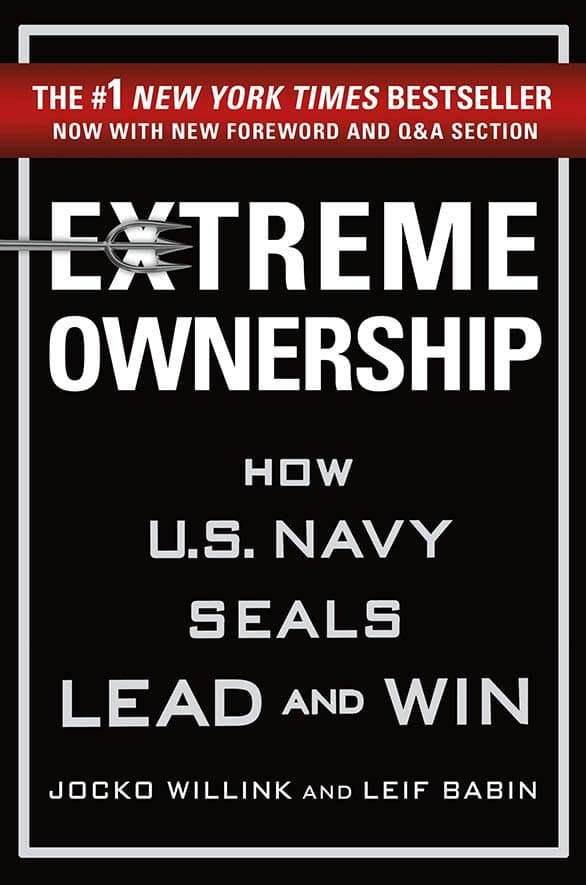Lessons In Leadership
There are many lessons one can learn from the leadership tactics of the Navy SEAL commanders. The complex combat situations of life and death that they deal with have underlying principles that can be applied to modern-day business.
Leaders in the tough business world have to take charge, make difficult decisions in difficult situations, and apply many strategies, much like commanders need to on the field.
Extreme Ownership (2015) by Jocko Willink and Leif Babin, two Navy SEAL task unit leaders, discusses these strategies that leaders in the business world can apply to overcome even the most challenging business battles.
Taking Responsibility For Failures
Every leader, just as every team, whether it is in the navy or in the corporate world makes mistakes. However, what separates good leaders from others is their willingness to take responsibility for their own failures, as well as those their teams make.
Jocko Willink, one of the authors, and a SEAL task unit commander in 2012 were in Ramadi, Iraq when he and his unit encountered heavy firing. What was initially thought of as firing from the mujahedeen, turned out to be firing from another SEAL unit. The chaos of the cross-firing led to the death of one of the soldiers.
Willink came forth and took the responsibility for the consequences. Owning up was what actually saved his job and he was allowed to keep command of the unit.
During SEAL training, when teams underperform or fail, many commanders are known to place blame on either the scenario itself, subordinates, or the troop itself. Commanders like Willink who man up and shoulder responsibility for the failure consider criticisms as constructive and make detailed notes from their failures to make improvements in strategy and in their leadership abilities.
Willink knew from the worst-case scenario training that he and his team undergo, that it is often during such training that a commanders attitude becomes apparent. He also understood from experience that when a bad commander places blame on others and the situations, the attitude of blaming passes on to other members in the unit. This, more often than not, results in the entire team becoming incapable and ineffectual.
On the other hand, subordinates of commanders who take responsibility for the failure of their team and their own actions, tend to show attributes akin to their commanders, ensuring that initiative and accountability flow down the chain of command.

Understanding The Importance Of Every Mission
A leader has to truly believe and fully understand the objectives of any project, task, or mission. In times, where an order or an objective seems questionable, a leader has to consider how it strategically aligns with the larger goals of the organization, and have a wider outlook of its actual implications for the future.
Willink once received an order from his commanders that his unit – impeccable and elite – would be fighting alongside a newly trained Iraqi Army. Feeling that the Iraqi teams were often poorly trained and equipped, and sometimes, known to be disloyal to their American counterparts, his first reaction was, “Hell No!”
He, however, kept his feelings to himself. He knew he had to find out why was the move implemented. He found that the move was actually a strategic one, as the involvement of the Iraqi army was intentional. It would eventually enable the US forces to withdraw their armies from the country.
With this understanding, he was able to truly believe in the mission and went ahead with discussing the move with his team. He was able to convince the team as well, and the team was able to carry out their orders with full commitment.
Had Willink shared his reservations with his team early on, he would have not only faced backlash, but an unconvinced team would have failed the mission too.
A leader is a part of something much bigger than himself and his team. Hence, if a leader does not understand a given directive, it is his responsibility to seek the right answers from those higher up. While questioning superiors can be daunting, securing the understanding of why an order is given an amount to not carrying out one’s responsibilities.
Allies Are Not Competition
For a leader, it is vital that he always considers and covers all possible options. While one eye has to be focused on the mission, one should be on covering the broader aspects, including other teams that could well offer strategic support. A leader has to understand that other teams within the same organization are too, working towards the same goal in the broader sense. They aren’t the competition.
While co-author Leif Babin was in Ramadi, he found himself and his unit deep inside the enemy territory without any backup. He had no option but to risk his team and walk across the city in broad daylight, with high chances of enemy attack.
While Babin and his unit made it to safety, Babin later realised that there was another SEAL unit close by. His myopic focus on the objectives of ‘evacuation without injury’ had led to consider one of the most fundamental tactics of ‘cover and move’. This SEAL tactic means that one has to work as a team and support all others to achieve the overall mission.
Babin had completely missed considering the positions of the other units and how their assistance could have prevented him from endangering his team unnecessarily.
In another instance, while Babin worked as a business consultant, he noticed that there was a rife competition within different teams of the same company. It is thus vital for leaders to understand and check such inter-organizational competition and remind the teams that they all work towards the same objective. The competition always lies outside the team.
Setting And Acting On Clear Priorities
One of the most important characteristics of good leaders is the ability to remain calm, even in the toughest of situations. At times, when there are more fires burning than one can put out, trying to tackle all issues simultaneously never helps.
In such cases, leaders should use the ‘prioritize and execute’ principle. Here, leaders should be able to make quick decisions on what issues take the topmost priority and then act on them.
Once in Ramadi, Babin’s team had moved on to what seemed the roof of a building, after exiting from the one beside it. the roof, however, was not a roof, but a tarp, resulting in one soldier falling through the covering and injuring himself 20 feet below. The unit was deep in enemy territory, exposed, vulnerable without backup and faced an enemy bomb at the exit of the building.
Babin was faced with multiple issues to focus on. However, his ‘prioritize and execute’ training principle helped him make the best possible decision. Babin saw that security was his first priority, reaching the wounded soldier his second, and getting a headcount of his unit’s men was the third. Despite the pressure, he was able to think calmly, assess the scenario, and take actions according to priority.
In the corporate world too, leaders need to calmly assess their tasks based on priority, communicate with their teams in a concise and simple manner, take key inputs from the higher command if any on the plan, and finally, focus the team into executing it. however, leaders should also keep in mind that priorities can shift, and communicating with the team about these changes is vital.

Identifying And Mitigating Risks Ahead Of Time
Leaders have the responsibility to plan for success. However, without identifying, quantifying, and mitigating all possible potential risks, success is elusive. Drafting out comprehensive contingency plans for all tasks at hand, and communicating these clearly to the team, help in not only reducing risks but also preparing the team for any plan that derails, at any point of time during execution.
While in Iraq, Babin received intelligence just before an operation to rescue an Iraqi hostage held by the Al-Qaeda, that the hostage was surrounded by explosives and guarded by bunker machine guns. The risk level of the operation instantly skyrocketed. However, Babin had already factored in the risks of the mission and moved forward as planned.
Babin, had, even before he knew the danger existed, estimated the potential risks of the operation into his comprehensive plans. Communicating the newly developed situation to his troops was simple due diligence. His thorough planning enabled him to execute as planned, without needing to change or postpone the operations due to the changed circumstances.
Preparedness is essential to any mission or project. Babin, in fact, always uses this situation as an example during training for new SEAL recruits. He often asks them, “Would they still go ahead with the mission after such risks come to light?” The right answer for this question is always, “Yes.”
Leaders should also be aware of the fact that despite all preparedness, some risks can’t be mitigated. In such scenarios, leaders should then focus first on the risks that can be controlled.
Giving Superiors The Information They Need
Questioning about one’s operation plans from superiors can sometimes come across as interference. At times, it can even seem like the top boss isn’t giving the leader and his team enough support. However, leaders should realize that it is always better to maintain good relations with superiors. Moreover, good leaders are aware of the fact that it is their responsibility to ensure that superiors have the correct critical information about the operation plans so that they can give their full support to decisions.
In Iraq, when Babin and Willink were SEAL unit commanders, Babin often approached Willink, complaining about the emails sent by their commanding officer. He felt the questions directed towards him by his commanding officer were stupid, pestering and a waste of his time.
Willink, however, explained that these questions were coming to him because he wasn’t taking the responsibility to provide the commanding officer with sufficient updates and details of his plans.
Babin eventually realized that these questions were aimed at getting the necessary information the officer needed to approve the plans, pass them up the chain of command for final approval, and make it possible for Babin to execute them. Babin also learned that he needed to check his own attitude and ensure that clear, highly detailed plan documents were sent to his superiors.
Being a good leader amounts to being able to influence both, those up and down the chain of command.
Conclusion
The learning one gets from the experiences of Willink and Babin as SEAL unit commanders are –
- Good leaders always take responsibility for their failures.
- They understand that every project or mission is important even when it doesn’t seem so.
- They understand that all teams within the organization are allies and not the competition.
- Good leaders must set clear priorities and act upon them.
- Risks should be identified, quantified, and mitigated well ahead of time.
- It is the responsibility of the leader to ensure that superiors get detailed information to help the execution of any plan.
Whether in the military, or the corporate world, leaders that take extreme ownership are the ones who find success.
